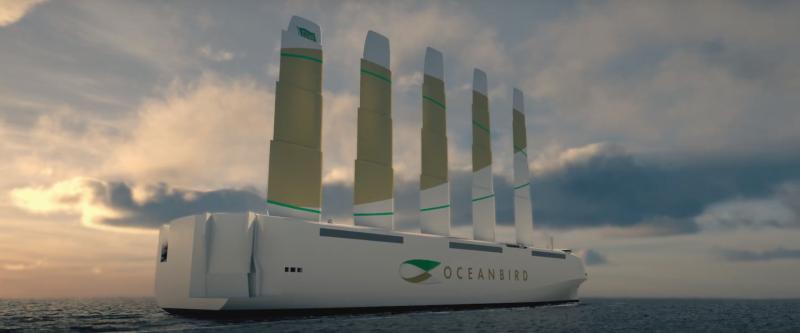 A Swedish consortium that includes Wallenius Marine has designed Oceanbird, a five-masted sailing car carrier, that could have a huge impact on the development of modern commercial sail. The design is intended to be finished in 2021 with potential delivery by 2025.
A Swedish consortium that includes Wallenius Marine has designed Oceanbird, a five-masted sailing car carrier, that could have a huge impact on the development of modern commercial sail. The design is intended to be finished in 2021 with potential delivery by 2025.
Oceanbird is a revolutionary design. It is not a small vessel. Whereas another sailing ro/ro project is working toward building a ship with a capacity of fewer than 500 vehicles, the Oceanbird design is a full-sized car carrier, 200 meters long with a 40 meter beam, and a capacity to carry 7,000 vehicles. If built, Oceanbird will be the largest sailing cargo ship that the world has ever seen.
Most large sailing assist projects have been distinctly incremental. Twin Flettner rotors on the Long Range 2 product tanker, Maersk Pelican, for example, have succeeded in reducing fuel consumption by almost 10%, which is right within the predicted range of outcomes.
By contrast, Oceanbird is designed to cut emissions by 90%. The ship will have engines for maneuvering and light airs but is intended to be primarily a sailing ship. Oceanbird will be powered by five telescoping rigid wing sails that will tower 80 meters over the ship. By comparison, the main mast of the clipper ship Cutty Sark is 47 meters tall.
Oceanbird will not be as fast as her fossil-fueled sisters. The Oceanbird is designed to cross the North Atlantic in 12 days, whereas a conventional car carrier would cross in eight.
In addition to Wallenius Marine, which is controlled by the founding family of the Wallenius RoRo shipping group — the consortium includes Sweden’s Royal Institute of Technology and shipping consultancy SSPA. The project is co-financed by the Swedish Transport Administration.
Wallenius Marine – Introducing Oceanbird
Thanks to Alaric Bond for contributing to this post.

This could possibly be the worst idea ever.
At first it seems a good idea but then wait a minute, what type of vessel has the highest capsize incident rate… car carriers, and they are planning to put five masts on it. I hope it will also have the world’s largest lead keel because their water ballast systems are highly prone to either operator error or malfunction.
Oceanbird was designed from scratch as a sailing vessel. Stability clearly factored into the engineering. I note that the design has more bean than comparable car carriers of her size.
I’m wondering about a keel not for ballast but for operational efficiency.
Navigation of this vessel will be more productive to the extent it is able to sail upwind, or for that matter with wind abeam and less leeway.
A substantially deep keel (full? fin?) would be a significant improvement over sailing cargo vessels of past times.
But oceangoing ships enter shallow harbors, not friendly to giant appendages. Yet we certainly have the technical ability to produce something along the lines of a huge daggerboard.
I suppose I should dig on this. I’ve a simple mind and better ones are working on the problem– I’m sure it’s been explored. 🙂
As a trucker I am wondering if it will be cheaper to take the slow boat. Presuming the receiver is willing to wait.
And they can enter the America’s Cup too.
It will need a wing keel for that 🙂
But it has got foils. Hasn’t it?
In online discussions, there have been references to movable skegs to improve balance and lift. If the hull looks like most car carriers, it will be relatively fine and “clipper” shaped.
A couple of questions:
1. When not loaded where is her center of gravity. Just how much really heavy weather can she handle.
2. What is her draft when loaded
3. What is her avg gross costs including staffing per unit when fully loaded
4. How many crew are needed
5. Does she have any auxiliary powered backup
6. Are there berthings in the North East that can take her length and also allow efficient unloading/loading
Wallenius Marine and their partners are still in the design phase of the projects so most of the answers to your questions are still not available to the public. That being said, I presume that when empty they will carry sufficient water ballast to ensure adequate stability. The ship is said to be slightly more expensive to build than a conventional car carrier but should cost significantly less to operate. The ship is designed for the North Atlantic auto trade so should have no problem operating from existing terminals. She is slightly beamier but about as long as conventional ships in the trade. Her masts which are about 80 meters high are retractable to allow to get under major bridges. The ship will have auxiliary engines which apparently have not yet been chosen.
And all I asked was a tall ship and a star to steer her by…